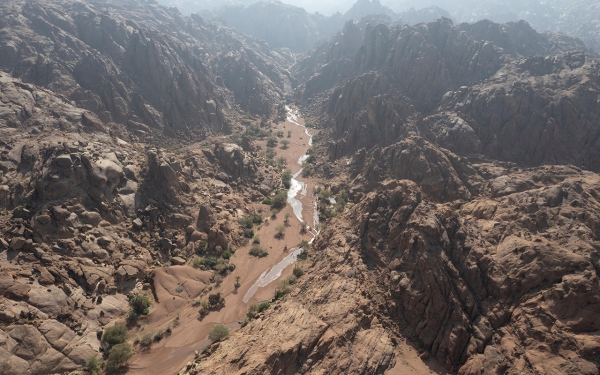
The Council of Royal Reserves is one of the entities responsible for the protection and development of natural reserves in the Kingdom of Saudi Arabia. The council was established by royal decree to identify the strategic directions of the royal reserve ecosystem, preserve its environmental and natural components, resettle wildlife therein, promote its development, and revitalize ecotourism, all while ensuring that each reserve retains its unique identity. Royal reserve development authorities have also been established to develop and implement strategies, plans, and all that pertain to operations management and implementation.
The Council of Royal Reserves was established by Royal Order on June 2, 2018, and is one of a handful of government entities bearing the title 'Royal', as it is one of the departments of the Royal Court.
Royal reserves are designated by order of the Prime Minister, and each reserve has a board of directors and a body that oversees their development. They enjoy legal personality and financial and administrative independence.
Organizational arrangements of the Council of Royal Reserves
The Council of Royal Reserves is chaired by the Crown Prince and Prime Minister, His Royal Highness Prince Mohammad Bin Salman Bin Abdulaziz, and composed of the following members: Prince Turki Bin Mohammed Bin Fahd Bin Abdulaziz Al Saud, Prince Mohammed Bin Abdulrahman Bin Abdulaziz Al Saud, Prince Abdulaziz Bin Saud Bin Nayef Bin Abdulaziz Al Saud, Prince Abdullah Bin Bandar Bin Abdulaziz Al Saud, Prince Badr Bin Abdullah Bin Mohammed Bin Farhan Al Saud, the Minister of Environment, Water, and Agriculture, and two specialist experts selected by the chairman.
Royal reserves in the Kingdom
There are eight royal reserves in the Kingdom, namely:
Prince Mohammed Bin Salman Nature Reserve: chaired by His Royal Highness Crown Prince and Prime Minister Prince Mohammad Bin Salman Bin Abdulaziz and includes the area between the NEOM Project, the Red Sea Project, and al-Ula. It spans an area of sixteen thousand km.
Imam Abdulaziz Bin Mohammed Royal Reserve: chaired by Prince Turki Bin Mohammed Bin Fahd Bin Abdulaziz Al Saud. After changing its name from the original Rawdat Khuraim Reserve, adjacent areas were added to the reserve after its adoption as a royal reserve. It spans an area of 11,300 km.
Imam Turki Bin Abdullah Royal Nature Reserve: originally al-Taysiyah Natural Reserve, it is chaired by Prince Turki Bin Mohammed Bin Fahd Bin Abdulaziz Al Saud. It spans an area of 91,500 km.
Imam Saud Bin Abdulaziz Royal Reserve: originally the Mahazat as-Sayd Reserve, it is chaired by Prince Abdullah Bin Bandar Bin Abdulaziz Al Saud. It spans an area of 2,240 km.
King Abdulaziz Royal Reserve: merged the former reserves of al-Tanhat and al-Khafs Reserves, then added adjacent areas, and is chaired by Prince Abdulaziz Bin Saud Bin Nayef Bin Abdulaziz Al Saud. It spans an area of 15,700 km.
King Salman Bin Abdulaziz Royal Natural Reserve: It is chaired by Prince Abdulaziz Bin Saud Bin Nayef Bin Abdulaziz Al Saud. It joins three former reserves: al-Khanfa, al-Tubaiq, and Harrat al-Harrat. It spans an area of 130,700 km.
King Khalid Royal Reserve: In October 2019, King Salman Bin Abdulaziz approved the transformation of ath-Thumamah Park in Riyadh into a royal reserve named the King Khalid Royal Reserve. It is chaired by Prince Turki Bin Mohammed Bin Fahd Bin Abdulaziz Al Saud and occupies an area of 720 km.
Imam Faisal Bin Turki Royal Reserve: On October 8, 2023, a Royal Order was issued to establish the Imam Faisal Bin Turki Royal Reserve. This reserve extends over three administrative provinces: Aseer, Jazan, and Makkah al-Mukarramah, encompassing areas within the Kingdom’s territorial waters in the Red Sea.
Importance of establishing the Council of Royal Reserves
The establishment of the Council of Royal Reserves comes as part of King Salman Bin Abdulaziz's endeavors to conserve the natural environment, propagate fauna and flora and wildlife, stimulate ecotourism, reduce overfishing and overgrazing, combat lumbering, preserve and increase vegetation, safeguard wildlife, preserve the natural and plant habitats, stimulate eco-tourism, organize movement within reserves without prejudice to villages, hamlets, and citizens' property within these reserves, in addition to providing an atmosphere for citizens and residents of the Kingdom to enjoy nature reserves.
Strategic objectives of royal reserves
On August 30, 2023, His Royal Highness Prince Mohammed Bin Salman Bin Abdulaziz, crown prince, prime minister, and chairman of the Council of Royal Reserves, announced the Council of Royal Reserves' approval of the strategic goals of the royal reserves for 2030. These strategic goals support royal reserves' comprehensive strategies, focusing on the protection of wildlife and afforestation activities, the promotion of ecotourism, and job creation. The approved targets of the royal reserves contribute to supporting the Kingdom's sustainability and environmental conservation efforts by contributing to the objectives of the Saudi Green Initiative to protect 30 percent of the land and marine areas of the Kingdom by 2030. The seven royal reserves constitute 13.5 percent of the total area of the Kingdom, plus growing more than eighty million trees in the Kingdom by 2030.
Royal reserves are premium destinations for ecotourism and establish the Kingdom's position as a leading tourist destination. The reserves aim to attract more than 2.3 million visitors annually, as well as to rehabilitate and protect more than fifteen archaeological and historical sites by 2030. Under these targets, royal reserves will protect and resettle more than thirty species of vulnerable and endangered species. These environmental and tourism targets are expected to result in the creation of many direct and indirect employment opportunities for local communities in royal reserves.
Related quizzes
Related articles


